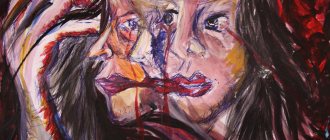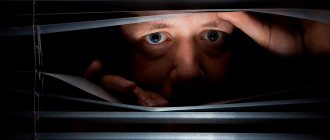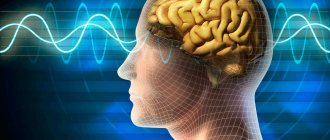Stages of disease development
The first signs of the disease appear in adolescence. This is isolation, isolation, reluctance to communicate with peers, and a depressive state. However, adults rarely pay attention to them, attributing them to the peculiarities and crises of this age period, so the disease can be recognized much later.
Experts identify several stages in the development of sluggish schizophrenia.
- The first, latent period. The symptoms are subtle and mild. At this time, the patient begins to show a tendency to philosophical reflection, thinks abstractly, and withdraws into himself.
- The second, manifest period. Signs of sluggish schizophrenia become more noticeable, their active manifestation is episodic. A person withdraws more into himself, he develops phobias, obsessions and fears, panic attacks, and sleep problems. The patient stops experiencing strong emotions and loses interest in his hobbies. It is at this stage that they usually “notice” the disease, turn to a psychiatrist, make an accurate diagnosis and begin treatment.
- The third stage is stabilization. People come to him as a result of a course of medication and psychotherapy. With favorable prognosis, the patient achieves a state of stable and long-term remission, continuing to take minimal doses of drugs to prevent relapse.
Negative symptoms in schizophrenia
Negative symptoms in the development of schizophrenia are called complete or partial loss of normal mental reactions. It includes a wide range of manifestations:
- smoothness of affect. Affect is the internal perception and outward manifestation of emotions. In schizophrenia, this process is very scarce, characterized by a poverty of emotions or their absence in principle. Such a person is not able to understand the feelings of others. This disorder is manifested by depression, mood lability, guilt, and fear. This leads to social maladaptation and isolation, since it is very difficult to establish contact with the patient. He begins to avoid people because he finds himself misunderstood;
- alogia – paucity of speech. She becomes poor and uninformative. If such patients are asked a question, the answer is usually short and concise. A woman suffering from the disease said that it was so difficult for her to speak that she was physically unable to explain her condition to her loved ones;
- Anhedonia is the inability to derive pleasure and enjoyment from activities that previously evoked positive emotions. Lack of motivation and activity to achieve it;
- sleep disturbance – problems falling asleep, insomnia, interrupted sleep;
- physical sensations – headaches and dizziness, malaise. Vestibular disorders are manifested by an unsteady gait, the person becomes clumsy. A characteristic symptom is stupor, as well as muscle hyper- or hypotonicity, small twitches.
Cognitive impairments are observed, which are sometimes also classified as negative symptoms. These are thinking disorders that manifest themselves as decreased attention and memory, lack of logic and the ability to reason.
The perception of sounds is distorted, the surrounding world seems blurry. The patient's anxiety worsens and he becomes withdrawn.
Forms of the disease
Sluggish schizophrenia comes in several types.
- The depersonalized form is a violation of self-perception of the individual and the boundaries of one’s own “I”.
- Neurosis-like – characterized by a weakening of the emotional sphere, apathy, dulling of feelings.
- Asthenic – expressed in rapid fatigue, a tendency to collect various objects.
- Obsessive – manifests itself in the presence of an obsessive state. The patient can perform the same action repeatedly and create rituals that only he understands.
- Hypochondriacal – develops against the background of changes in the patient’s hormonal levels, during adolescence, during pregnancy or menopause in women. A person is confident that he has a dangerous, sometimes fatal disease, and considers his state of health to be critical.
- Psychopathic - characterized by foolishness, an arrogant attitude towards others, delusions and hallucinations.
- Affective form - a person falls into a depressive state, analyzes his actions and actions, or experiences constant fluctuations from sharp enthusiasm to complete apathy. These extremes replace each other, each time causing a deterioration in the patient’s well-being.
- Latent form - the symptoms of sluggish schizophrenia are mild and do not progress to the active stage. This type of disease has the most positive treatment prognosis.
Diagnostics
When making a diagnosis, a psychiatrist relies on studying the patient’s family history and the presence of symptoms according to the ICD. The diagnosis is established after several months of monitoring the person’s mental state.
The psychiatrist conducts conversations not only with the patient, but also with members of his family. He is interested in issues of human behavior, analyzes the data obtained, and pays attention to the dynamics of the formation and progression of symptoms. In addition to the procedures described, the prospective patient must undergo a number of diagnostic tests:
- MRI;
- computed tomography;
- encephalography;
- duplex scanning;
- psychological testing;
- neurotesting.
Hardware techniques are important for excluding or confirming organic brain pathologies. Timely and thorough diagnosis plays an important role in the subsequent treatment of pathology. Timely examination and treatment is the key to recovery.
Clinical conversation plays an important role in the diagnostic process. This is communication between a doctor and a patient within a consultation or hospital setting. Due to the high risks of genetic predisposition, it is important to carefully examine the family history. Cases of “familial schizophrenia” were first described by researcher E. Kahnom. This is a form of schizoid congenital constitution, the presence of axial disorders or pathologically productive symptoms in the disease picture. Diagnosis of the disease is complicated by pathology that develops from adolescence.
Pre-existing conditions
At the premorbid stage (before the formation of schizophrenia), there are complaints of symptoms of borderline disorder. This is the presence of increased impressionability, a dynamic affective sphere, an overly vivid imagination, and a lack of stress resistance. At the initial stages of pathology, pronounced social isolation, sensitivity to intrapersonal conflicts, and social coldness in communication are noted. The individual's self-awareness is unstable.
One of the precursors of pathology is the presence of previous suicide attempts. Therefore, diagnosis should include studying the patient’s biography.
Before the onset of affective pathologies in adolescence and adolescence, psychogenic and psychosocial stress are present. These include the loss of one of the parents, moving to another house or city, changing the place of education, etc. Before schizophrenia, apathetic depression, psychopathic-like mania, and mixed affective states are often present. The described phenomena are often combined with substance abuse or substance abuse. At the same time, there is a change in the form of alcohol intoxication towards aggression and psychomotor overexcitation.
Children's forms of pathology
The manifestation of childhood forms of sluggish schizophrenia is possible from the age of 7 years. The first signs are noticeable in the child’s behavior - it becomes inadequate. Many fears arise, the child begins to talk with an imaginary interlocutor. There is a list of signs of the early stages of the sluggish childhood form:
- the presence of paranoid fears and statements;
- isolation from the society of other children increases, and the inability to build friendly relationships;
- the child becomes more capricious;
- there are sudden changes in mood;
- problems develop with speech abilities and the ability to build logical chains;
- problems with consistency when expressing your thoughts are noticeable;
- in a conversation, the child produces phrases that are not related to the topic of the conversation;
- strange, previously unusual hobbies and interests arise;
- interest in previously favorite toys and entertainment disappears.
It is impossible to rely only on the described manifestations of pathology - it is important to show the child to a psychiatrist for an accurate diagnosis.
In adolescents, low-grade schizophrenia also begins with a change in interests, mood swings, and the appearance of suicidal thoughts and intentions. The child's behavior seems strange. You can hear philosophical or religious statements of a dubious nature from a teenager. Sometimes there is fanatical adherence to the canons of traditional religions.
Teenagers' hobbies undergo changes. Instead of apathy and abulia, intense activity often occurs with pretentious, non-standard, previously unusual hobbies. A child becomes embittered if someone starts to interfere with his ability to engage in new hobbies. In this case, the patient’s activity is unproductive and meaningless.
Features of signs of sluggish schizophrenia
This type of mental disorder is characterized by the manifestation of two typical signs of behavior change.
- Foolishness, clowning, eccentricity, awkward and unkempt appearance. The man looks like an eccentric - he is not dressed for the weather, he moves uncertainly, his movements are clumsy and angular. Speech disturbances also occur. It becomes saturated with complex phrases, thoughts become ragged and devoid of logic. You can often observe an abrupt transition from one topic to another.
- Pseudopsychopathization . It is expressed by increased emotional excitability and the presence of overvalued ideas. The patient is not able to perceive criticism addressed to him and adequately evaluate his actions.
If you notice strange behavior in a loved one, it’s time to sound the alarm and take action. Call the “Balance” clinic by phone: +7 (499)495-45-03 . We will answer all your questions, advise you on what to do, and, if necessary, fill out an application for a doctor to be called to your home at any time of the day.
Schizophrenia and its causes
The first mention of schizophrenia, or schizophrenia as it was called, dates back to the 17th century BC. But, naturally, a clear, clear definition of the disease was not given then.
This concept was introduced into psychiatry in 1908 by the Swiss psychiatrist Eugen Bleuler. He clearly limited this concept from other mental disorders and defined it as a separate disease.
Literally, from Greek, the disease is translated as “split of the mind.” But this concept should not be compared with a split personality. It is also impossible to draw parallels between this term and dementia. The basis of schizophrenia is a violation of the coordinated functioning of the psyche, a breakdown of connections between its components: perception, thinking, attention, emotions. As a result of this, it cannot work as a single mechanism, causing all kinds of failures.
The reasons for the development of such a disorder have not been precisely and definitively established. To date, there are only theories of the occurrence of such a condition:
- Heredity.
- Risk factors during pregnancy. People born during the winter and spring months are thought to be more likely to develop the disease. Prenatal infections and gene mutations also play a role.
- Social status. It has been established that the development of schizophrenia is influenced by such criteria as low material level, racial persecution, lack of work, family problems, isolation from society, and loneliness.
- Childhood traumatization. Manifestations of the disease in adulthood are provoked by traumatic factors suffered by a person in childhood: sexual and physical violence, loss of parents, lack of proper upbringing and care.
- Psychological conditions. Increased emotionality, decreased resistance to stress.
- Excess dopamine. Excessive release of the neurotransmitter dopamine in the brain leads to constant stimulation of the “reward system”, which causes most of the symptoms. However, this hypothesis is increasingly fading into the background.
- Addiction.
- Changes in some brain structures. For example, enlargement of the ventricles and decrease in gray matter.
Symptoms and signs of low-grade schizophrenia
A feature of this type of mental disorder is the absence of pronounced productive and negative symptoms. The patient is not very different from normal, healthy people, and is able to lead a socially active life. Although the symptoms of the disease do not lead to personality degradation, they affect changes and deformation of behavior, thinking, areas of interest and manner of communication.
There are 7 symptoms of low-grade schizophrenia.
- Depersonalization . The patient is satisfied with his own “I”, as well as the ability to express his opinions, thoughts and feelings.
- Finding flaws in your appearance. A person is critical of himself, dissatisfied with his appearance, weight, and can lead himself to anorexia.
- Hysterical state. It is typical mainly for women. Through hysterics and tears, the patient tries to attract attention to himself.
- Solitude, isolation. A person does not want to go out, communicate with peers and immediate surroundings. The extreme manifestation of this symptom is the development of autism.
- Aggressive and affective behavior , uncontrollable outbursts of anger and irritability.
- Dulling of feelings , loss of the ability to empathize, disturbance of the emotional sphere.
- Demonstrative behavior , arrogant attitude towards others, unfounded criticism of them.
Such alarming symptoms should at least concern relatives and force them to consult a specialist. You can call our “Balance” clinic by phone: . We will make an appointment with an experienced psychiatrist. Or make an appointment yourself.
When can a diagnosis of schizophrenia be made for symptoms of psychopathy?
Sluggish schizophrenia is sometimes very similar to classic psychopathy. The hallmark characteristic of a diagnosis of schizophrenia is bizarre, inexplicable or inappropriate behavior that occurs in adulthood or adolescence.
In addition, with sluggish psychopathic schizophrenia, unmotivated anger, leaving home, strange fantasies, sloppiness, pronounced pathological hobbies and increasing rejection of other people may be noted. The patient’s worldview and fantasies are so unusual and absurd that they cannot “take root” even in an asocial company, a religious sect or an occult society.
In psychopathic-like sluggish schizophrenia, metaphorical, pretentious speech, stereotypical, amorphous or excessively detailed thinking is noted. Strange sexual desires, increased aggressiveness and delusional short-term states may appear, which are combined with auditory hallucinations.
Timely diagnosis and treatment can reduce the symptoms of the disease, allowing a person to live an almost normal life. Our clinic employs experienced specialists who will help you overcome the manifestations of the disease that are destroying your life.
You can make an appointment with a psychiatrist by phone
(812) 407-24-26
Difficulties in diagnosis
Due to the slow progression and mild severity of symptoms, the diagnosis of “sluggish schizophrenia” is made already at the active stage of the disease. The complexity is also caused by the similarity of the symptoms of schizophrenia with a neurotic disorder. Only an experienced doctor is able to draw a clear line between these diseases and confidently make a diagnosis.
A psychiatrist at our clinic will conduct a detailed medical history, talk with the patient and his relatives, identify signs of low-grade schizophrenia, conduct laboratory tests and neuropsychological tests. Depending on the results of the study and classification of the form of mental disorder, an individual course of therapy will be selected.
Differences from neurosis
The most important difference between neurosis and psychosis (sluggish schizophrenia) is the presence of a critical attitude towards one’s own pathology. With psychosis, patients are unable to assess their health status or track specific symptoms. With neuroses, there is a greater chance of adapting to the conditions of society. With schizophrenia, a person tends to deny the presence of obvious problems and shift the blame to the people around him.
Another difference between sluggish schizophrenia and neuroses is that the first pathology, without treatment, can transform into a more serious and severe mental disorder. In classical neurosis, manifestations of obsessions and hypochondria are less pronounced than in schizophrenia.
Treatment of the disease
Sluggish schizophrenia is the mildest type of this type of mental disorder, so its treatment and achievement of a state of remission requires smaller dosages of medications. The doctor prescribes atypical antipsychotics, nootropics, antidepressants and tranquilizers to the patient. At your request, if there are no obvious signs for hospitalization, we can conduct a course of drug therapy in a hospital setting. We have all the conditions for this - comfortable and bright VIP category rooms, without sharing, 2 and 3 beds. After discharge from the hospital, treatment can be continued on an outpatient basis.
During the rehabilitation period, it will be necessary to continue taking medications, but in minimal doses. To prevent the risk of relapse, we recommend regularly visiting a doctor at our clinic and following all his recommendations. We provide treatment on an anonymous basis. After discharge, our patient will be able to return to an active social life without fear of disclosure and condemnation from others.
You can get advice and ask any questions that concern you by calling: +7
Obligate symptom of schizophrenia
One of the obligatory negative symptoms of schizophrenic disorder is abulia - lack of willpower. Characterized by a loss of desire and motivation for any kind of activity that previously aroused interest. Such people are passive and lack initiative.
As the disease progresses, abulia develops into apato-abulia syndrome, an extreme degree of volitional disorder. A typical picture: a person is constantly alone, sitting or lying down, he can watch TV all day, but does not grasp the meaning of what he is watching. He refuses to take a shower, perform morning daily procedures, get a haircut, sleeps without changing clothes, and defecates anywhere.
At the same time, it is possible to intensify some unconscious instincts: sexual or food. The latter is manifested by uncontrolled absorption of food.
Such patients do not make verbal contact; their speech is poor. They explain their refusal to engage in dialogue by saying that they are tired.
Another distortion of the volitional sphere is parabulia. It is manifested by unfinished activities, impulsiveness and pretentious actions.
The patient is characterized by ambivalence - duality of reasoning and action. For example, he declares himself fat and thin, devil and god.
Another symptom is negativism. The patient performs contradictory actions. If someone hands him an apple, he refuses. But as soon as the fruit is removed, the person asks for it again.
All these negative symptoms can be primary, arising as a consequence of a pathological process, or secondary. They appear under the influence of external factors and often become negative attitudes towards the patient from others, close people and long-term hospital treatment.
A special role is played by the use of certain medications, in particular antipsychotics. But when they are canceled, the negative symptoms also disappear. This is an indicator by which you can determine whether the symptoms are progression of the disease or a side effect of treatment.
Living and managing life with schizophrenia
This requires a significant number of caring, involved people. Family involvement, peer support, and the care and support of a loved one is no small feat for all of these people. How do you react when someone claims they are being hunted by aliens? Or that the government has installed spyware in their home and transmits orders directly to their brain? When caring for a loved one suffering from behavior change, it is helpful to keep in mind that this is a biological disease. Express your concern and motivate them to see a doctor. Once they receive treatment, encourage them to stick with it. Do not ridicule their delusions, do not minimize their impact on your loved one, and do not attach importance to any hallucinations that they may have. In the end, for a person suffering from schizophrenia, all this is quite real.
Signs of latent schizophrenia
This form of the disease is characterized by a long prodromal period, during which not every specialist can make a diagnosis. As the disease progresses, certain symptoms come to the fore, according to which the following types of disorder are distinguished:
- obsessive-phobic;
- hypochondriacal;
- with a predominance of depersonalization;
- hysterical.
Separately, simple sluggish outpatient schizophrenia is considered; its first manifestations occur at an early age. A gradual decline in academic performance and difficulties in mastering school material are noted. Typical:
- loss of emotions (anhedonia);
- episodes of apathetic depression;
- cognitive deficit;
- confusion in thoughts;
- impaired coordination of attention;
- poor memory;
- fast fatiguability;
- weakness, weakness.
At the same time, patients are capable of normal communication, possess the necessary self-care skills, and can perform simple tasks and duties.
Obsessive-phobic sluggish schizophrenia
Possible:
- depersonalization and derealization syndrome;
- the phenomenon of “taking the incredible for reality”, accompanied by ideas of accidental and unintentional harm to others, obsessive doubts about committing violence or murder (for example, such thoughts appear after an accidental collision with another person on the street), and the patient often returns several times to the “scene of the crime” "to check your doubts;
- obsessive phobias of physical pollution and moral defilement, often accompanied by senestopathies - unpleasant sensations in different parts of the body, without clear localization, not associated with any disease, injury, etc.;
- obsessive ideas of self-accusation, one's own imperfection, unfulfilled debt.
Almost all patients experience agoraphobia, which is much more severe than with ordinary anxiety disorders. Very often, panic attacks occur, accompanied by generalized anxiety and disturbances of consciousness.
Phobias of external threats are also typical - fear of foreign substances (poisons, radiation), sharp objects (needles, glass) entering the body. A person does not realize the unreality of such fears, so he carries out some kind of “cleansing rituals”, for example, disinfecting objects, repeated heat treatment of clothes, and does not use household appliances, which, in his opinion, emit dangerous waves. There are frequent episodes of self-aggression; being afraid to leave the house, a person may quit work or study, and isolate himself from communication. He feels safe only in his own apartment (room).
Over time, obsessions acquire a completely absurd character, elements of a compulsive disorder appear: the patient repeatedly performs the same actions, for example, changing clothes, brushing teeth, cleaning, etc.
Hypochondriacal form
Painful or simply unpleasant sensations with localization mainly in the epigastric region, chest, and spine come to the fore. Patients often seek medical help, avoid physical activity so as not to harm themselves even more, maniacally strive for recovery, and often resort to quite extraordinary methods.
Sometimes the disorder is accompanied by a feeling of lightness, weightlessness of one’s own body, periodic sensations of flying or falling, muscle emptiness or, conversely, tension and cold. Patients also complain of tingling and burning in the body.
Hypochondriacal seizures are possible, which clinically resemble panic attacks, but last much longer - from half an hour to several days. The following symptoms are typical for this condition:
- severe anxiety;
- fear of loss of control over one’s own body, impending disaster, approaching death;
- pain without clear localization.
During a hypochondriacal attack, the patient is restless, constantly calls a doctor or an ambulance, demands examination, treatment, and insists on surgical intervention.
Latent schizophrenia with depersonalization syndrome
It is characterized by a state of alienation, changes in the inner world, a feeling of duality of one’s own “I,” and impoverishment of emotions. At the same time, they note a decrease in overall vitality, a lack of initiative and activity. The brightness and clarity of perception of the environment disappears, the ability to empathize is lost, the patient does not show either pleasure or disappointment - emotional emptiness develops. All actions and actions are perceived as something alien, “mechanical”.
Hysterical form of the disorder
Hysterical symptoms take on a frankly hypertrophied form: affectation, mannerism, and grotesque coquettishness predominate. Often an obsessive attraction to some object develops with frank stories about extraordinary love, ideal relationships, while there is a complete absence of a critical attitude towards such delusional ideas.
Treatment and care for patients with schizophrenia
There are several treatment methods and therapies aimed at eliminating the symptoms. If you suffer from this condition, you can take antipsychotics and undergo psychosocial techniques. Antipsychotics are the most common form of treatment for people with schizophrenia. They significantly reduce positive symptoms by affecting the neurotransmitter systems of the brain.
The second level of treatment includes cognitive and behavioral therapy to “retrain” the brain after antipsychotics reduce positive symptoms. In addition, cognitive behavioral therapy improves self-care skills and teaches mechanisms for coping with emotions and behavior, so that schizophrenics can lead almost normal lives - going to work, college and maintaining close relationships.
Coordinated specialty care includes a full course of treatment, including medication, psychosocial therapy, family involvement, and employment services to help the person complete their plans and return to normal life. The SSP project is aimed at changing the usual course of illness of people suffering from schizophrenia, and orienting them towards a productive, independent life.
Etiology
To date, the exact cause of low-grade schizophrenia is unknown. The theory of hereditary predisposition, which is based on the results of many years of clinical research, received the most confirmation. At the same time, when examining patients, certain organic changes in the structure of the brain, an imbalance of the main neurotransmitters, and endocrine disorders are noted. It is assumed that some external factors act as a trigger: either severe psychological trauma, or chronic stress, overwork.











